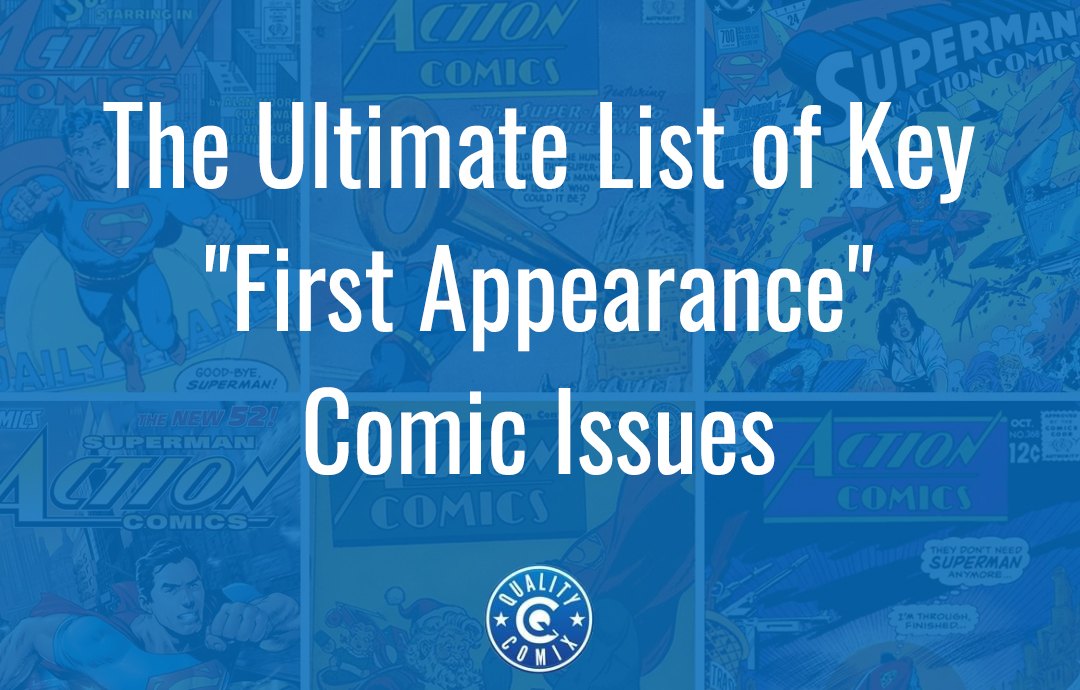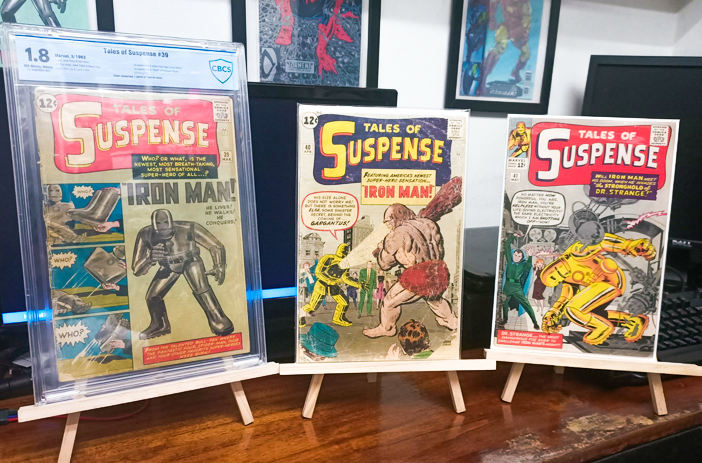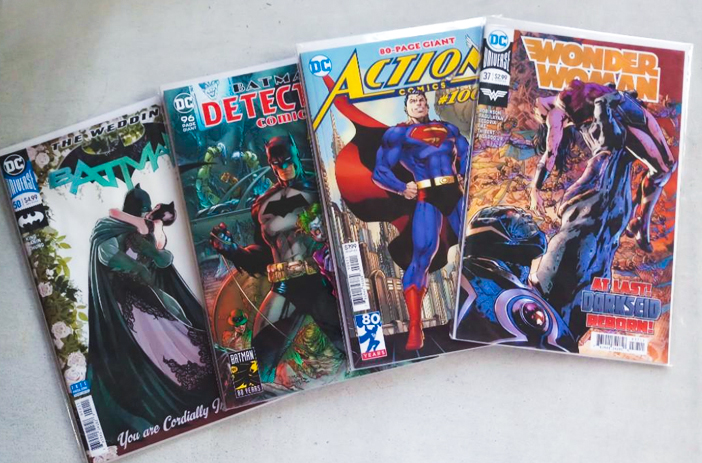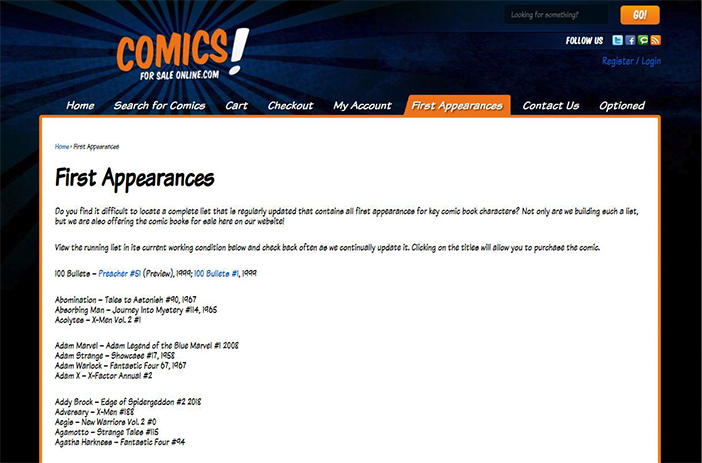
When collecting comics, you generally learn about the phrase "key issue" very quickly. Key issues are issues of a comic where something important happens. Two of the most iconic are Action Comics #1 and Superman #75, illustrating both kinds of key issues.
Action Comics #1 is the introduction of Superman, the first comic he was ever in. It's broadly known as the most expensive comic in the world, though it's easily obtainable if you don't mind one of the many, many reprints that have been created over the decades.
Superman #75 is a key issue of another sort. Rather than introducing a character, it's a significant event in the comic's history. In this case, Superman #75 is the notorious Death of Superman issue, a flagship element of the 90s comic era "dark ages" and the propensity of publishers in that era to both kill off significant characters and start crossover events with significant happenings.
Today, we're going to focus specifically on "first appearance" key issues. These are, as mentioned, key issues wherein individual characters first debut. There are, however, some complications with this.
- Sometimes a team is made up of a bunch of pre-existing characters; the first appearance of the team together is a key issue but may not be as relevant to some people as the actual first appearances of those characters.
- Sometimes a character appears in the final panel of the last page of a comic, with their first full appearance being the subsequent issue. The most famous case of this is Wolverine, who had a one-panel preview in Incredible Hulk #180 but is generally considered to first appear in Incredible Hulk #181.
- Some characters have more than one identity. Green Lantern is a famous example, with different people taking up the mantle. Each one has their own first appearance, but there's only one first appearance of Green Lantern as a concept.
- Retcons can make older non-key issues into key issues if they turn an older character into someone noteworthy, though this doesn't always make the original version more valuable. Spider-Man villain Hobgoblin's first appearance in a comic is much more valuable than the first appearance of the character he was eventually revealed to be.
Key issues often have a generally-accepted definition, with some variability based on unique facets of the characters. It's often down to collectors and comics fans, through interest and through buying and selling, to determine what the definitive key issues are.
Though the title of this post is an ultimate list of key first appearances, there are far, far too many characters in the 100+-year history of comics to truly list them all. Instead, we've chosen the most noteworthy first appearances, as well as a few that indicate some of the quirks of key issues.
Table of Contents
What Makes a Key Issue Valuable?
Key issues are more valuable than the average issue of a comic series, but what makes the keys so much more valuable?
The first is, obviously, because they're key. The first appearance of a character makes that issue more valuable than an issue where nothing new or significant happens. This might seem strange for those of us who grew up reading comics in the 80s and 90s, where it seemed like every single issue was an artificial key with some crazy event happening, but comics didn't use to try to make every issue noteworthy in that way.
A big part of the value of a key issue is who is being introduced. A prime example of this is the difference between Tales of Suspense #39 and Better Comics #1. Both of these are debuts of Iron Man, but they are two very different characters, one of which has no relation to the modern popular Marvel hero. When a character never takes off and never becomes popular, the key issue that debuted them is still a key issue, but demand is significantly lower. Thus, value is as well.

Image source: Google Images
A big part of it all is, of course, supply and demand. The more popular a character or event is, the more interested collectors there will be, and thus the more demand there will be for the comic. Thus, a higher price.
Age is also important here. You'll notice that the vast majority of the most valuable comics are from the 40s through the 60s. That's because after the 60s, print runs and popularity in comics started to increase dramatically, and more and more people started collecting and keeping comics around in good condition. Part of why the 1940s comics are so valuable is simply because they're so rare; very few comics were kept at all, let alone in good condition, so a high-quality copy of a key issue can be worth a lot of money from the right age.
When you get right down to it, age is the biggest determining factor of how valuable a comic can be. Even the cheapest of the comics from the 1940s is going to be on par with a key issue from the 2000s simply because there were so many more of the latter printed. Scarcity is a huge determining factor.
Most Noteworthy First Appearance Key Issues
Let's go through things with a bit of chronology, shall we?
The Detroit Mirror, October 4, 1931: First appearance of Dick Tracy. Unlike many other key issues on this list, this is a newspaper debut.
Action Comics #1, 1938: First appearance of Superman. Widely considered to have launched the superhero comics industry altogether, Superman's first appearance is also the most valuable comic of all time, selling for a record $3.4 million just last year.
Detective Comics #27, 1939: First appearance of Batman (and James Gordon). This issue was so influential that the company publishing it, National Comics Publications, changed their name to the now-globally-known DC Comics.
Mystery Men Comics #1, 1939: First appearance of Blue Beetle.
Marvel Comics #1, 1939: First appearance of Human Torch and Namor the Submariner.
Captain America Comics #1, 1940: The first appearance of Captain America and Bucky Barnes, later known as the Winter Soldier.
Whiz Comics #2, 1940: The first appearance of Captain Marvel (also known as Shazam). Unique in that there is no Whiz Comics #1, so this is technically the first issue of the series.
Batman #1, 1940: The first appearance of two of Batman's most famous arch-enemies, the villain Joker and the antihero Catwoman.
Detective Comics #38, 1940: The first appearance of Batman's perennial sidekick, Robin.
All-American Comics #16, 1940: The debut of Green Lantern, though the man wearing the ring, Alan Scott, isn't one of the most popular Green Lanterns.
Flash Comics #1, 1940: The first appearance of the first character to weaponize super-speed and bear the mantle of The Flash, Jay Garrick.
Action Comics #23, 1940: The first appearance of one of Superman's most famous nemeses, Lex Luthor.
All Star Comics #8, 1941: The debut of Wonder Woman, one of the world's most famous female superheroes.
Pep Comics #22, 1941: The debut of Archie Andrews, the star of the self-named Archie Comics years later.
More Fun Comics #73, 1941: The first appearance of Aquaman, though in a much different form than he takes these days. Green Arrow also debuted in this issue.
More Fun Comics #101, 1942: The first comics starring Superboy, back when he was just a young Superman and not an independent character.
Better Comics #1, 1941: The first appearance of the first Canadian superhero, Iron Man. Don't get them mixed up, though; this Iron Man has no relation to and bears no resemblance to the popular Marvel Iron Man.
Of course, if we're going to continue chronological order, we'll never make it out of the 40s.

Image source: Google Images
Here are some other key issue first appearances you might want to look into.
Showcase #4, 1956: The debut and first appearance of the second Flash, the arguably much better-known and more popular Barry Allen.
The Incredible Hulk #1, 1962: The first appearance of the title character, The Incredible Hulk.
Amazing Fantasy #15, 1962: The first appearance of Spider-Man, humble Peter Parker's arachnoid alter-ego. This is easily the second most valuable comic of all time, behind Action Comics #1.
Journey Into Mystery #83, 1962: This is the first comic appearance of the superhero Thor. Though Thor has been a character in Norse mythology for centuries, this iteration of the character is very different from his mythological counterpart, at least for a while.
Tales of Suspense #39, 1963: The first appearance of Iron Man, this time for real. The Canadian Iron Man never caught on, but this one – a man encased in an iron suit, looking very much like a robot – certainly did.
X-Men #1, 1963: The first appearance of several of the X-Men, and generally considered one of the most character-packed debut issues around. This is also the first time the X-Men team debuted, as well as the first appearance of their nemesis Magneto.
The Avengers #1, 1963: Unlike the X-Men, which largely debuted as a team with other characters joining over time, The Avengers was put together from pre-existing characters. This is the debut issue of the team name and concept, but not the characters themselves.
The Amazing Spider-Man #129, 1974: The first appearance of the much-debated Frank Castle, also known as The Punisher.
Teenage Mutant Ninja Turtles #1, 1984: The first appearance of the titular turtle team. This is particularly valuable as it was an indie publication and had a much lower print run than many comics of the time.
Akira #1, 1988: The first appearance of the titular Akira. This just goes to show that it's not always just American comics that have key issues; Japanese Manga has just as much to consider in terms of keys as American superhero comics.
Journey Into Mystery #85, 1952: The first appearances of several of Thor's supporting cast, including Heimdall, Odin, and the ever-popular Loki. This is an excellent example of how key issues can change according to modern sensibilities; this issue was worth a lot before, around $170k, but when the Loki TV show spun up, an easy $100k was added to the price of the book. Not bad, right?
Finding Your Favorite Keys
Key issues are all over the place. If you're looking to browse through first appearances, it can be a very interesting rabbit hole. These days, many contemporary superheroes feel like they've been together for so long they must have started out as a team, right? Then you find out that sometimes there were ten or twenty years between them, and you realize just how many characters have come and gone over the years.
This site has a massive list of first appearances, alphabetized rather than run through by year. If you're curious about when your favorite hero, villain, team, or other character started out, this is a great place to check.

Remember, though, that many heroes are names more than people, and often several people can wear the mask. Take, for example, Green Lantern. His various iterations have debuted in All American Comics #16, 1940; Showcase #22 (Hal Jordan), 1959; Green Lantern #48 (Kyle Rayner), 1994; and Green Lantern #87 (John Stewart), 1972. Which one do you pick? Well, which one is your favorite?
If you're looking to collect your favorite keys, you can always feel free to browse our active sales. We carry a lot of graded and ungraded comics, including many of the best keys out there, and all you need to do is browse.

On the other hand, if you have comics to sell, we're more than happy to help. Maybe you have a collection you don't know how to appraise? If so, drop us a line with a description of your collection and a few pictures, and we can help you appraise them and advise you on the next steps you can take. Alternatively, if you know what you have, we can help you out with any part of the sales process. We're also more than happy to just talk shop! We're all comic fans here, after all.



